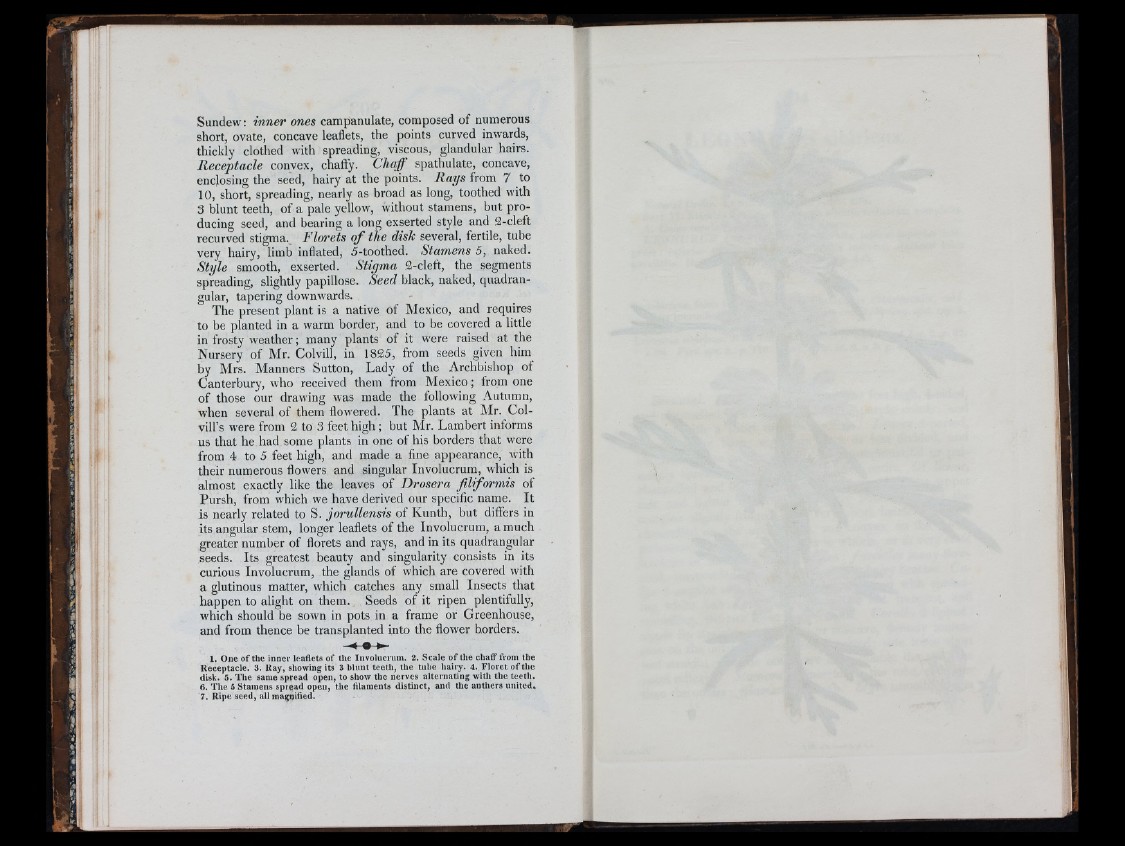
Sundew: inner ones campanulate, composed of numerous
short, ovate, concave leaflets, the points curved inwards,
thickly clothed with spreading, viscous, glandular hairs.
Receptacle convex, chaffy. Chaff spathulate, concave,
enclosing the seed, hairy at the points. Rays from 7 to
10, short, spreading, nearly as broad as long, toothed with
3 blunt teeth, of a pale yellow, without stamens, hut producing
seed, and bearing a long exserted style and 2-cleft
recurved stigma. Floi-ets o f the disk several, fertile, tube
very hairy, limb inflated, 5-toothed. Stamens 5, naked.
Style smooth, exserted. Stiyma 2-cleft, the segments
spreading, slightly papillose. Seed black, naked, quadrangular,
tapering downwards.
The present plant is a native of Mexico, and requires
to be planted in a warm border, and to be covered a little
in frosty weather; many plants of it were raised at the
Nursery of Mr. Colvill, in 1825, from seeds given him
by Mrs. Manners Sutton, Lady of the Archbishop of
Canterbury, who received them from Mexico; from one
of those our drawing was made the following Autumn,
when several of them flowered. The plants at Mr. Col-
vill’s were from 2 to 3 feet h igh; hut Mr. Lambert informs
us that he had some plants in one of his borders that were
from 4 to 5 feet high, and made a fine appearance, with
their numerous flowers and singular Involucrum, which is
almost exactly like the leaves of Drosera filiformis of
Pursh, from which we have derived our specific name. It
is nearly related to S. jorullensis of Kunth, hut differs in
its angular stem, longer leaflets of the Involucrum, a much
greater number of florets and rays, and in its quadrangular
seeds. Its greatest beauty and singularity consists in its
curious Involucrum, the glands of which are covered with
a glutinous matter, which catches any small Insects that
happen to alight on them. Seeds of it ripen plentifully,
which should be sown in pots in a frame or Greenhouse,
and from thence be transplanted into the flower borders.
1. One o f the inner leaflets of the Involucrum. 2. Scale o f the chaif from the
Receptacle. 3. Ray, showing its 3 hhmt teeth, the tube hairy. 4. Floret o f the
disk. 5. The same spread open, to show the nerves alternating with the teeth.
6. The 5 Stamens spread open, the filaments distinct, and the anthers united»
7. Ripe seed, all magnified.